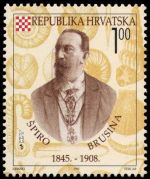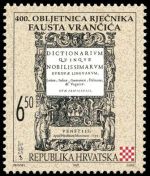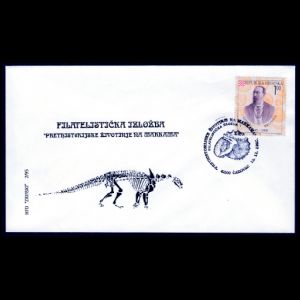Croatia 1995 "The Anniversary of Croatian Science I"
| <prev | back to index | next> |
| Issue Date | 30.10.1995 |
| ID | Michel: 349-351, Scott: 269-271, Stanley Gibbons: 397-399, Yvert et Tellier: 324-326, Category: pP |
| Design | Hrvoje Sercar, painter and graphic designer, Zagreb Ratko Janjic, academic painter, Zagreb Darko Jakic, academic painter and graphic artist from Zagreb |
| Stamps in set | 3 |
| Value |
1 kn - Spiridon Brusina 2,2 kn - Bogoslav Sulek 6,5 kn - THE ANNIVERSARY OF CROATIAN SCIENCE |
| Emission/Type | commemorative |
| Places of issue | Zagreb |
| Size (width x height) | 29.82mm x 35.50mm |
| Layout | |
| Products | FDC x1 |
| Paper | white 115g, gummed |
| Perforation | 14 |
| Print Technique | Multicoloured offset print |
| Printed by | "Zrinski" - Cakovec |
| Quantity | 350.000 each |
| Issuing Authority | The Croatian Post and Telecommunications |

On October 30th, Croatian Post and Telecommunications issued the set of three stamps "The Anniversary of Croatian Science".
 |
He was among the first to notice the importance of scientific research into the depths of the Adriatic and claimed the sea was a source of life and living species.
He was the founder of maritime biology in Croatia.
He was particularly interested in birds and set up the beginnings of ornithology in Croatia.
He analyzed and classified 600 fossil species.
 |
 |
Bogoslav Sulek was born in 1816 in Slovakia.
He studied in Pozun (today Bratislava) and attended the Evangelist College where he read philosophy, theology, law and natural science.
At the end of 1838 he came to Brod on Sava. He studied Croatian and started correspondence with Ljudevit Gaj. Sulek's interest in philology resulted in writing a dictionary that was published in 1860 as the two-volume "German-Croatian Dictionary".
The Ilyrian Movement kept alive the awareness of the importance of the Croatian language in schools and cultural institutions in Croatia.
Sulek spent ten years working as chief editor of the dictionary. The dictionary of scientific terminology was published in 1875.
The title was "Hrvatsko-Njemacki-Talijanski rjecnik znanstvenog nazivlja".
Faust Vrancic, who was born in 1551 in Šibenik, studied at the Padua University and later became a secretary to the emperor and king Rudolf II at a royal court in Prague, where he came in contact with many scientists and scholars.
He published several works on ethics, theology, history, philology and technology. In 1595 he published his worldwide famous dictionary of "the five most respectable European languages" under the title "Dictionarium Quinque Nobilissimarum Evropae Linguarum, Latinae, Italicae, Germanicae, Dalmatinae, Ungaricae".
All Croatian entries are in Vranicic's Chakavian dialect with some elements of the Slokavian dialect. The "Dictionarium" is the first comprehensive dictionary of the Croatian and Hungarian languages.
Products and associated philatelic items
| FDC | First-Day-of-Issue Postmark | Special Cover |
 |
 |
 |

|
References
Technical details and short description of the stamps:Croatian Post (the article doesn't available anymore), Colnect.
Acknowledgements
Many thanks to Dr. Peter Voice, PhD Department of Geological and Environmental Sciences, Western Michigan University, USA, for review of a draft of this article.| <prev | back to index | next> |